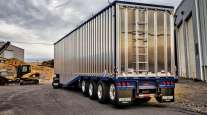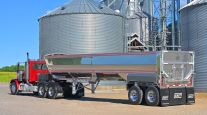Contributing Writer
Trailer Makers Use Composites, Materials to Extend Life, Limit Moisture and Overloading
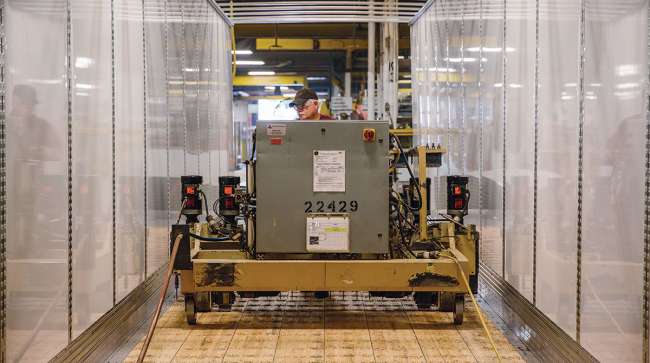
[Stay on top of transportation news: Get TTNews in your inbox.]
Amid a challenging landscape of supply chain issues, manufacturers are extending the lives of trailers using products such as composite materials and galvanized elements.
The most vulnerable element in a trailer is the floor, which is constantly attacked by moisture and overloading. To protect against moisture, much of the industry is using wood and resin composite floors. Wood is a general-purpose material and is cheaper, while aluminum is lighter and more durable, particularly with high-cycle fleets that do a lot of loading and unloading, said Nick Clinkenbeard, product manager of dry and refrigerated vans at Wabash.
Floor maker Havco uses 100% oak because of its natural decay resistance, said Bruce Bader, president and CEO, and Gopal Padmanabhan, vice president of product development. Padmanabhan helped invent the composite floor, Bader said. Prior to that, trailers were built first with sawed lumber floorboards laid on the crossmembers, and then the industry moved to laminated wood where lumber boards were cut into strips and glued along the edge to make unitary floorboards up to 53 inches in length.
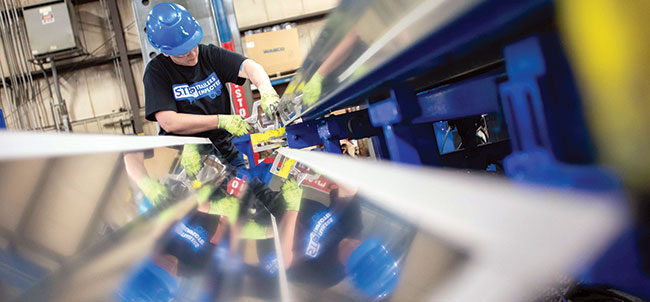
A Stoughton employee works on a front corner panel. (Stoughton Trailers)
The biggest threat to wood is moisture on the topside, where it can pool and cause damage from top to bottom. Wood actually increases its moisture content to 12%-14% after it’s installed and on the road because of humidity, Padmanabhan said. With the added moisture content, the boards can widen up to 1/16th of an inch, filling the joints and improving the fit. But if water pools on the topside, the moisture content can increase up to 25%-30%, causing swelling, warping, damage to floor screws and then decay. Once the floor decays, it loses its strength rapidly.
Bader said the company’s latest flooring can last up to 15 years, which is long after many fleets have sent the trailer to the secondary market. The boards can be covered on the top, bottom or both by a proprietary coating. They also can be covered by an 8-millimeter-thick polyurethane coating. Another wax-based coating can be sprayed or brushed on the topside, then reapplied every 3-4 years. To prevent the rot that can occur underneath, the floor is reinforced with a 1/16th-inch, high-strength composite sheet that’s impervious to water and makes the board twice as strong.
Rockland Flooring offers four customizable solutions to protect trailers against moisture, said Chris Wolford, chief sales officer. It requires only periodic visual inspections and no recoating or other repairs. Rockland offers two surface protection packages for the floor’s more vulnerable topside. Together, the elements can help prevent a most-likely expensive floor replacement .
Jim Jannell, national sales manager for floor manufacturer Prolam, said moisture attacks glue lines on the floor’s top and bottom surfaces and will wick its way up through the hook joints to the top surface, resulting in wood joint swelling, glue line separation, and wet and damaged cargo. He said Prolam’s zig-zag style floor joints stop water before it intrudes from below. Prolam also offers two optional products that can extend floor life by five to seven years. It applies a polyurethane hot-melt coating to the bottom side over the wheels or across the trailer’s length.
The top side can be dipped in paraffin that protects the glue lines and wood from moisture, heat and cold fluctuations.
OEM Approach
Trailer manufacturer East uses mostly aluminum flooring because of its strength and durability, said Chris Cooler, vice president of sales and marketing. A coating prevents the electrolytic reactions that occur between aluminum and steel interfaces. It also seals out moisture and road de-icing chemicals. The manufacturer installs a 20-millimeter high-density polyethylene plastic between the metals. East also seals all lighting systems and installs control switches and main valves in a weatherproof enclosure, and it’s spec’ing more galvanized steel components.
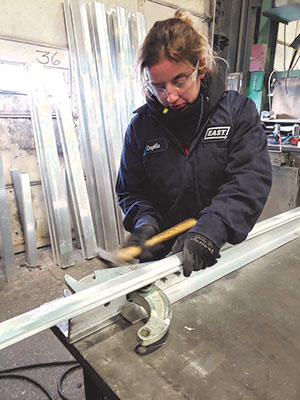
East Manufacturing noted that its challenges are centered around employee recruitment and retention. (East Manufacturing)
While the floor is the most vulnerable part of the trailer, other parts are subject to moisture intrusion. David Giesen, vice president of sales for Stoughton Trailers, said Stoughton is transitioning painted components to zinc-coated galvanized products to protect them from corrosion. A third-party vendor performs on-site galvanizing beside the company’s manufacturing plant.
Clinkenbeard noted the walls of Wabash’s new refrigerated trailers consist of a foam composite impregnated by resin so moisture doesn’t penetrate, rather than having the traditional design with an outer skin, structural members, and foam in between. The moisture can degrade the foam and increase weight by a couple of hundred pounds over 2-3 years.
Trailer manufacturer Great Dane stopped using wood in its reefer market years ago, a change Chris Hammond, executive vice president of sales, said prevents corrosive de-icer chemicals from wicking into the floor sill. Instead, it’s using composite materials. It also uses a thermoplastic liner that is lighter and stronger than those used in previous generations.
Fleets can extend trailer life by closing doors when it’s raining, preventing roof leaks, and avoiding washing the floor. Rockland’s Wolford said the rear 8-10 feet are the most vulnerable because they are exposed to rain and ultraviolet light when doors are left open. Both weaken the wood fiber and cause glue lines to delaminate.
He said the company tries to educate customers on their products.
“We still see too many carriers pressure-washing their trailer floors, which is probably the worst thing you can do to a laminated floor,” he said. “The expansion and contraction of the wood during the wetting and drying process will weaken the floor and the glue lines, resulting in costly repairs.”
Overloading
In addition to moisture, the floor’s other enemy is overloading. A forklift can weigh up to 20,000 pounds and can load very heavy products like an 8,000-pound paper roll, Padmanabhan said. Because the front axle is carrying about 90% of the load, the weight is applied to a small floor area. Also affecting the floor’s longevity is the load cycles, or the number of times a floor section carries the weight of forklifts and clamp trucks.
“It’s really the loading and the unloading where the damage happens,” Bader said. “Once the load is in there and it’s distributed over the floor, the amount of mileage that you do down the highway with it has really very little effect.”

We still see too many carriers pressure-washing their trailer floors, which is probably the worst thing you can do to a laminated floor.
Chris Wolford
Padmanabhan advises fleets to specify floors according to what they are hauling. Fleets transporting lighter loads can work with the shipper to use a smaller forklift. Wabash sells a combination of wood and aluminum floors where the forklifts run on the aluminum. Rockland’s Wolford said a trailer floor’s longevity depends on how the trailer was specified, loading frequency, how the trailer is used and the fleet’s maintenance practices. It’s not uncommon for trailers 15 or 20 years old to be used in their original application. Such long-lasting floors have been a growing market for Rockland the past seven years that’s driven largely by private fleets, the less-than-truckload sector, grocery and other specialized fleets focused on maximizing service life. Manufacturers offer floors that are designed for particular applications.
“Fleets will often buy a standard dry van with a basic floor rating and then put it into paper service down the road,” he said. “The floor system was not engineered for this type of service, so the results are devastating and expensive. Sometimes it just takes one loading of the wrong cargo to create a catastrophic failure.”
Clinkenbeard said trailers can run more than 20 years. Trade cycles are being extended out of necessity in a constrained market. He said this past summer, some used trailers sold at higher price points than new ones. Wabash expects demand to be strong through this year and next.
Economic Concerns
The trailer industry like other industries has been challenged by the pandemic. Giesen said that “almost all components and materials have been and continue to be in different levels of shortage.” Havco’s Bader said lumber, glue, composite materials, machinery parts and cutting tools at times were in short supply, and prices have increased. But the supply chain has improved, and most of what Havco buys can be purchased in North America. Clinkenbeard said delivery has improved over recent months. Manufacturers aren’t seeing the widespread issues of 12 months ago, and those issues are becoming less disruptive.
East’s Cooler said his company doesn’t rely on many overseas parts and has encountered limited supply chain disruptions. Its biggest challenge is hiring and retaining personnel. The company expects to rely more on automation in the next five years because of that issue and to increase product quality and consistency.
Great Dane’s Hammond said manufacturers are still struggling with labor issues and with the supply chain.
Want more news? Listen to today's daily briefing above or go here for more info
“The supply chain has good days and bad it seems,” he said. “So yes, there are still challenges here.”
Telematics will be standard next year on new Great Dane trailers. Hammond expects other manufacturers will do the same. When that happens, trailers may face the same supply chain issues related to microchips that have plagued vehicle manufacturers.
Wabash’s Clinkenbeard said trailer manufacturers are no longer immune.
“Five years ago, you might have said that trailers are completely insulated from that,” he said, “but now the digital space is coming to the trailer market as well, so we’re a little more exposed to that than we were, but still not necessarily to the same level as the auto industry.”


